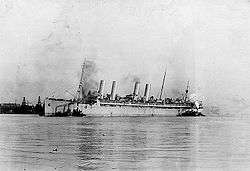Action of 5 September 1918
| Action of 5 September 1918 | |||||||
|---|---|---|---|---|---|---|---|
| Part of World War I Atlantic U-boat Campaign | |||||||
 USS Mount Vernon after being torpedoed and under escort by another allied ship which is laying a smokescreen. | |||||||
| |||||||
| Belligerents | |||||||
|
|
| ||||||
| Commanders and leaders | |||||||
|
|
| ||||||
| Strength | |||||||
|
1 auxiliary cruiser 4 destroyers | 1 submarine | ||||||
| Casualties and losses | |||||||
|
36 killed 13 wounded 1 auxiliary cruiser damaged |
none 1 submarine damaged | ||||||
The Action of 5 September 1918 was a naval battle 200 mi (170 nmi; 320 km) off the coast of France in the North Atlantic during World War I. The action was fought between a German U-boat and American warships.
Background
SS Kronprinzessin Cecilie was a German ocean liner operating between the U.S. and Europe. On the outbreak of the war, she sought refuge in the then-neutral United States to avoid the British Royal Navy and was taken into Bar Harbor, Maine, where she was interned. After America entered World War I in April 1917, the ship was seized and turned over to the United States Navy, who renamed her USS Mount Vernon in honor of Mount Vernon.
Mount Vernon was used to transport American troops across the Atlantic to France.
U-82—a German submarine— had several successful patrols of the Atlantic to sink any and all Allied shipping.
Action
On the morning of 5 September 1918, Mount Vernon and four destroyers were off France and steaming in a convoy toward the U.S. when Mount Vernon was attacked by U-82. The German vessels' periscope was spotted 500 yd (460 m) off the starboard bow, by a man of Mount Vernon's gun crew; they immediately fired a round from the gun.
The shot was a hit. Apparently unaffected by the shot, which reportedly did not harm anyone, U-82 surfaced. The U-boat fired a single torpedo at Mount Vernon and then submerged. The American captain ordered "right full rudder" but the ship could not turn fast enough and was hit.

The destroyers USS Winslow, Conner, Nicholson and Wainwright responded immediately and approached the battle area. Once they arrived near Mount Vernon, they observed the damage from a large explosion on Mount Vernon′s side.
The German commander, seeing the fast-approaching American destroyers, decided not to follow up with a second torpedo, so no further damage to the U.S. auxiliary cruiser was sustained. The four destroyers dropped depth charges for many minutes after Mount Vernon was hit, but they failed to sink the U-boat, which slipped away.
Despite this, the American destroyers were credited with saving Mount Vernon from being sunk. Mount Vernon steamed safely back to Brest with the loss of 36 out of the 1,450 people on board. Thirteen others were wounded; all of the American casualties were the result of the single torpedo explosion.
The ship suffered considerable damage, but after immediate improvised repairs, she was able to return to Brest under her own steam with an allied warship for additional protection.
Aftermath

Further temporary repairs were made at Brest, and from there Mount Vernon proceeded to Boston, Massachusetts for a complete repair. This was Mount Vernon's last battle of the war and one of the bloodier days for the U.S. Navy during the conflict with Germany. U-82 continued to fight, as did the four U.S. destroyers.
See also
References
- Drechsel, Edwin (1994). Norddeutscher Lloyd, Bremen, 1857–1970: History, Fleet, Ship Mails, Volume 1. Vancouver, British Columbia: Cordillera Pub. Co. p. 191. ISBN 978-1-895590-08-1. OCLC 30357825.
- Putnam, William Lowell (2001). The Kaiser's Merchant Ships in World War I. Jefferson, North Carolina: McFarland. ISBN 978-0-7864-0923-5. OCLC 46732396.
- Halpern, Paul G. (1995). A Naval History of World War I. New York: Routledge. ISBN 978-1-85728-498-0.
- Roessler, Eberhard (1997). Die Unterseeboote der Kaiserlichen Marine. Bonn: Bernard & Graefe. ISBN 978-3-7637-5963-7.